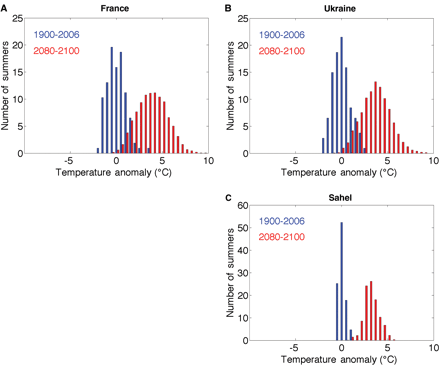[I’m on travel, so I’m updating this timely 2009 post on food insecurity.]
The quote above is the powerful final sentence from a 2009 study in Science, “Historical Warnings of Future Food Insecurity with Unprecedented Seasonal Heat.” The University of Washington news release release explained:
Rapidly warming climate is likely to seriously alter crop yields in the tropics and subtropics by the end of this century and, without adaptation, will leave half the world’s population facing serious food shortages, new research shows….
“The stresses on global food production from temperature alone are going to be huge, and that doesn’t take into account water supplies stressed by the higher temperatures,” said David Battisti, a University of Washington atmospheric sciences professor.
Yes, this 2009 study is a serious underestimate of the speed and scale of likely impacts for two reasons.
First, the conclusions are solely based upon projected temperature rise. They don’t even consider the potentially more devastating impact from more extreme drought and Dust-Bowlification (See NCAR analysis warns we risk multiple, devastating global droughts by mid-century even on moderate emissions path) — let alone the combination of heat stress and water stress together.
Second, as is common in such analyses, the authors based their simulations on “the ‘middle of the road’ emission scenario, A1B.” In 2100, A1B hits about 700 ppm with average global temperatures “only” about 3°C (5 F) warmer than today. In fact, on our current emissions path, a 3C temperature rise will happen much sooner (see Hadley Center: “Catastrophic” 5-7°C warming by 2100 on current emissions path and M.I.T. doubles its 2095 warming projection to 10°F — with 866 ppm and Arctic warming of 20°F). And remember, the worst-case scenario is that this happens by mid-century (se Royal Society special issue details ‘hellish vision’ of 7°F (4°C) world — which we may face in the 2060s!)
Figure. “Histogram of summer (June, July, and August) averaged temperatures (blue) observed from 1900 to 2006 and (red) projected for 2090 for (A) France, (B) Ukraine, and (C) the Sahel. Temperature is plotted as the departure from the long-term (1900–2006) climatological mean (21). The data are normalized to represent 100 seasons in each histogram. In (A), for example, the hottest summer on record in France (2003) is 3.6°C above the long-term climatology. The average summer temperature in 2090 [assuming A1B] is projected to be 3.7°C greater than the long-term climatological average.”
The results are still alarming:
We used observational data and output from 23 global climate models to show a high probability (>90%) that growing season temperatures in the tropics and subtropics by the end of the 21st century will exceed the most extreme seasonal temperatures recorded from 1900 to 2006. In temperate regions, the hottest seasons on record will represent the future norm in many locations.
If the authors had modeled the Hadley or M.I.T. or other current business-as-usual scenarios, then I suspect even in the temperate regions, growing season temperatures in 2100 would exceed the most extreme temperatures recorded in the past century — while the tropics and subtropics will be utterly brutalized.
In the tropics, the higher temperatures can be expected to cut yields of the primary food crops, maize and rice, by 20 to 40 percent, the researchers said. But rising temperatures also are likely to play havoc with soil moisture, cutting yields even further.
Indeed, along with the temperature rise, we face desertification of one third the habited planet and moderate drought over half the land mass. Soil moisture drops over large parts of the planet will exceed that of the 1930s Dust Bowl! And lasting a long, long time (see NOAA: Climate change “largely irreversible for 1000 years,” with permanent Dust Bowls in Southwest and around the globe).
“We have to be rethinking agriculture systems as a whole, not only thinking about new varieties but also recognizing that many people will just move out of agriculture, and even move from the lands where they live now,” Naylor said.
Currently 3 billion people live in the tropics and subtropics, and their number is expected to nearly double by the end of the century. The area stretches from the southern United States to northern Argentina and southern Brazil, from northern India and southern China to southern Australia and all of Africa….
“When all the signs point in the same direction, and in this case it’s a bad direction, you pretty much know what’s going to happen,” Battisti said. “You are talking about hundreds of millions of additional people looking for food because they won’t be able to find it where they find it now.”
The study warns that the rich countries will also suffer:
Severe heat in the summer of 2003 affected food production as well as human lives in Europe. Record high daytime and nighttime temperatures over most of the summer growing season reduced leaf and grain-filling development of key crops such as maize, fruit trees, and vineyards; accelerated crop ripening and maturity by 10 to 20 days; caused livestock to be stressed; and resulted in reduced soil moisture and increased water consumption in agriculture. Italy experienced a record drop in maize yields of 36% from a year earlier, whereas in France maize and fodder production fell by 30%, fruit harvests declined by 25%, and wheat harvests (which had nearly reached maturity by the time
the heat set in) declined by 21%.
Yet, by century’s end, the European summer of 2003 will be considered relatively cool. What do the authors recommend?
It will be extremely difficult to balance food deficits in one part of the world with food surpluses in another, unless major adaptation investments are made soon to develop crop varieties that are tolerant to heat and heat-induced water stress and irrigation systems suitable for diverse agroecosystems. The genetics, genomics, breeding, management, and engineering capacity for such adaptation can be developed globally but will be costly and will require political prioritization. National and international agricultural investments have been waning in recent decades and remain insufficient to meet near-term food needs in the world’s poorest countries, to say nothing of longer-term needs in the face of climate change.
Rather lamely, the study never mentions the possibility of mitigation, of keeping total global warming to far less than 3°C, as a strategy. Why? The final paragraph of the release states:
“You can let it happen and painfully adapt, or you can plan for it,” he said. “You also could mitigate it and not let it happen in the first place, but we’re not doing a very good job of that.”
Okay. Fine. Another understatement of the year.
But since the authors clearly assert in the study that we’re also not doing a very good job of adaptation or investment in agriculture, I’m not sure why it makes more sense for them to push adaptation as a solution than mitigation. In fact, we’ll need to do both, but absent serious mitigation, “climate adaptation” may be little more than cruel doubletalk for most of the world [see Real adaptation is as politically tough as real mitigation, but much more expensive and not as effective in reducing future misery; Rhetorical adaptation, however, is a political winner. Too bad it means preventable suffering for billions].
[Note to authors — if you ignore mitigation, than you need to model an emissions scenarios that does not have much if any mitigation. Try A1F1 next time.]
If we end up with 5.5°C warming or more by century’s end, and if you throw in the desertification and sharps drops in soil moisture — plus the loss of the inland glaciers that act as reservoirs for so many major river systems around the globe — then simply developing crops “that are tolerant to heat and heat-induced water stress” along with better irrigation is likely to prove utterly inadequate and irrelevant for billions of people.
And let’s not forget where we’re ultimately heading — Science stunner: On our current emissions path, CO2 levels in 2100 will hit levels last seen when the Earth was 29°F (16°C) hotter
The only genuine hope for avoiding “the worst form of triage” is aggressive and immediate greenhouse gas mitigation.
For more, see the posts under the category “food insecurity.”



